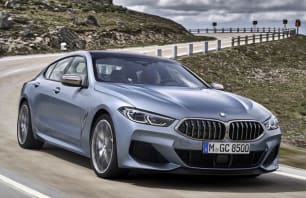Although it kicked off as a roadster, a coupe version of the F-Type was always part of the plan. In fact, Jaguar's C-X16 concept, that in 2011 previewed the eventual production car, was a hardtop.
Following the Coupe's public reveal at the 2013 Los Angeles motor show, I asked Jaguar's then head of design, Ian Callum, if the bean counters had vetoed the concept's ultra-cool side-opening hatch door; one of many styling hat tips to the E-Type. His response was a wry smile and slow nod of the head.
It's a shame that door didn't make it to the showroom floor, but the E-Type is still a strong design influence on its successor.
At close to 4.5m long, around 1.9m wide, and a fraction over 1.3m tall, the F-Type R looks more compact in the metal than it does in photographs, arguably the hallmark of a successful sports car design.
A long, flowing (front-hinged) bonnet (Jaguar calls its shape 'liquid metal' sculpture) projects forward from a rear-set cabin, with broad but tightly wrapped haunches behind it. The 20-inch, 10-spoke rims (in 'Gloss Black' with diamond-turned finish) fill the wheel arches perfectly.
I'm a huge fan of the tail-light cluster design, subtly reprofiled in the late 2019 update, which echoes the shape of the Series 1 E-Type and other classic Jags, but found it harder to warm to the outgoing F-Type's squarish headlight treatment.
Always a subjective call, but to my eyes this car's slimmer, more feline (LED) eyes and ever-so-slightly larger grille deliver a better front to rear balance. And slender, flush-fitting pop-out exterior door handles remain sub-zero cool.
Our 'Santorini Black' test car had been optioned with the 'Exterior Black Design Pack' ($1820) for an extra hint of menace. It applies body-colour to the front splitter, side sills, and rear diffuser, at the same time blacking out the grille surround, side vents, side window surrounds, rear valance, Jaguar script, F-Type badge and 'Leaper' emblem.
Jaguar describes this two-seater as a '1+1', confirming the F-Type's focus on the driver, and our test car's tan leather interior emphasises the fact.
Tan dash on the passenger side, complete with flying buttress-style grab handle for extra support when g-force starts to build. Contrasted by all black and all business on the driver's side.
A broad centre stack houses the 10-inch multimedia touchscreen, with easy-to-use dials for the climate control system below. And the 12.3-inch reconfigurable hi-def instrument cluster (with graphics unique to the F-type) is a model of clarity and simplicity.
The latter offers a choice of display themes, including full nav map, but the default mode highlights a large central tachometer. Nice.
An impressive design feature carried over from the previous model is deployable front air vents. The dashtop remains flat until a given climate control temperature setting causes an upper section, housing a pair of adjustable vents, to gently rise. Very cool (no pun intended).

